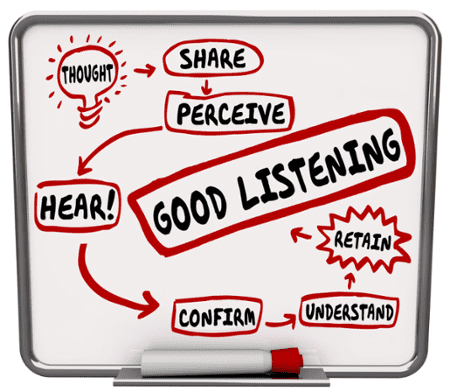The Value of Specific Leadership Competencies
Obviously communication is a core competency. Studies have found that 70-80% of a leader’s time is spent in communication, mainly with those who report to them. Probably for this reason communication is a major predictor of leadership effectiveness.
Traditionally most communication (75%) has been verbal rather than written. Much of what is communicated in face to face encounters is done non verbally by facial expression, gestures, posture and tone of voice. Research shows that people place more credence on the non verbal communication than on what is actually said when verbal and nonverbal messages differ.
With the increase in online teams the use of visual cues in leadership communication is reduced, and the frequency and quality of communication becomes even more important.
A common language and shared understanding is key to effective communication. In most cases this is missing and clarification is needed. For both virtual and on site teams there are relevant principles for achieving this clarification – vital for effective leadership communication.
Use of Dialogue

Research into communication style in teams has found that the ‘dialogue’ approach – defined as “a shared inquiry, a way of thinking and reflecting together” 2 is associated with better team task performance.
In a Norwegian study3 four aspects of the communication dialogue competency were measured;
- learning orientation—the belief that one can learn from team mates
- open and respectful disagreement – being respectful when disagreeing, and not belittling those with other opinions.
- inquiry and exploration— exploring the different views and opinions of team mates
- building on diverse perspectives – listening to other opinions and attempting to take them into account when presenting one’s own views.
Another study of management meeting effectiveness found this last point to have a significant positive impact on task performance.
How to create a climate for dialogue (6)
- People must feel they are among equals – that their contribution is needed and unique. Circular seating helps by removing status differences.
- A facilitator is needed to ensure everyone gets a chance to speak, though they may choose not to contribute. There must be enough time allowed so that the conversation is not restricted to those people who speak first and their issues and ideas.
- It needs to be clarified that this is an exploratory process to gain understanding – a decision does not have to be made.
- People must be encouraged to share their feelings respectfully when their opinions are challenged or preferably to suspend their interpretation pending further clarification.
- The leader or facilitator needs to help identify assumptions and perceptions that may be based on unconscious bias
Respectful Inquiry
Respectful enquiry as a communication technique is one way of getting people to open up and engage in dialogue. It is defined as the process of asking a question, in an open way, and listening carefully to the answer. 1
Such communication is deemed “respectful” because asking a question, without in any way using its format to limit the answer, sends a message that the opinion is considered valuable.
Question openness varies from rhetorical questions requiring no answer (How should I know?) to closed questions requiring only a yes or no answer (Can I help you with that?), commands phrased as a question (you did complete that order?) to very open questions that invite a full response. (What do you think should be the priority?)
However open questions such as ‘What is the problem?’ can be asked in a ‘disrespectful’ way that suggests the person should not respond at all. So tone and non verbal communication must also be respectful.

Listening
The attentive listening part conveys respect and valuing of the opinion. Allowing oneself to be distracted conveys the opposite.
“Listening requires discipline. Discipline to keep one’s mouth shut. How long can you listen without interrupting? In the average doctor-patient interview, studies show, the doctor interrupts the patient before the latter has talked for 17 seconds. We probably do the same thing with family and with work colleagues, especially subordinates. 5

Attentive listening requires eye contact, attentive body language, avoidance of distraction, feedback such as nodding or verbal encouragement to continue. At appropriate points checking our understanding of what we heard by repeating or paraphrasing.
Effective listening means considering what the person is implying as well as what they actually say.
Theory of Respectful Inquiry
It is suggested that respectful enquiry promotes the satisfaction of 3 fundamental needs that people have in their lives and workplace.
- to feel in control
- to feel competent
- to feel they belong
When these needs are met people feel more engaged.
When a leader asks an open question of a team member they are in effect giving them control over the conversation and signalling their confidence in the competence of the person to respond. Being part of the conversation promotes a sense of relatedness, belonging in the team.
How to promote use of Respectful Inquiry & Dialogue
Most workplace settings are not conducive to respectful inquiry. Organizational culture plays a large part in this. Many organizations operate in a control oriented culture where processes are formalized so as to reduce the need for individual discretion and communication.
Cultures that are very hierarchical are also likely to inhibit dialogue and open communication. Research shows that leaders who are more powerful are more likely to dominate the conversation, more likely to stereotype others, and be reliant on their own knowledge, less likely to listen to others.7
Three other work environment factors are likely to impact communication style. When leaders are time pressed they will be more likely to use directive statements. When they are not physically close to their team the opportunity for exploration and dialogue is limited. When they are mentally stressed and overloaded they are likely to try to reduce complexity rather than invite new information in order to cope.

On a personal level leaders who themselves feel a lack of autonomy and personal competence are likely to be defensive and to communicate mostly via statements and directives. They may not feel secure enough themselves to ask for the opinions of team members.
Finally people who are by disposition less open to new information, less agreeable and more arrogant are also less likely to use dialogue and respectful inquiry.
Paradoxically in all these situations the work environment is likely to be one of low engagement where the the basic employee needs for autonomy, competence and belonging are not well met.
Leadership development needs to promote an awareness of the dynamics of culture, leadership style and specific communication competencies in order to promote improved employee engagement and organizational effectiveness.
The Centranum Competency Management platform provides a means to define, develop and track leadership competency. Learn More
References
1. Van Quakebeke, N., Felps, w. (2018) Respectful Enquiry – A motivational account of leading through asking questions and listening. Academy of Management Review Vol. 43, No. 1, 5–27.
2. Isaacs, W. (1999). Dialogue and the art of thinking together. New York, NY: Currency
3. Bang, H., & Midelfart, T. N. (2010). Dialogue and effectiveness in management teams. Tidsskrift for Norsk Psykologforening, 47, 4 –15
5. Linney Jr., George E., (1995) Communication Skills – A Pre Requisite for Leadership. Physician Executive, 08982759, Vol. 21, Issue 7
6. Schein Edgar downloaded from https://thesystemsthinker.com/the-process-of-dialogue-creating-effective-communication/
7. Tost, L. P., Gino, F., & Larrick, R. P. (2012). When power makes others speechless: The negative impact of leader power on team performance. Academy of Management Journal, 56: 1465–1486.

